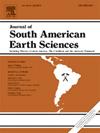Phrynops Wagler, 1830 (Testudines, Chelidae) in the Late Miocene of Palo Pintado Formation, Salta Province, Argentina, with comments on taxonomy and paleoenvironmental settings
IF 1.7
4区 地球科学
Q3 GEOSCIENCES, MULTIDISCIPLINARY
引用次数: 0
Abstract
Pleurodiran chelid turtles are represented from the Late Miocene in northeastern and northwestern Argentina by species assigned to Phrynops sensu stricto = Phrynops geoffroanus complex. In the northeastern region, these turtles include the extinct species Phrynops paranensis (Wieland, 1923) from the Ituzaingó Formation, Entre Ríos Province. On the other hand, from the Late Miocene of northwestern Argentina, Phrynops specimens involve unnamed species coming from El Morterito (Cajon Valley, Catamarca Province) and Andalhualá (Tiopunco, Santa María Valley, Tucumán Province) formations. In this contribution, a new and relatively complete specimen assigned to Phrynops sensu stricto (Phrynops sp.) from the upper levels of the Palo Pintado Formation exposed in Quebrada Salta (Salta Province) is described and compared. The particular morphology of the specimen analyzed, different both from Phrynops paranensis, the only extinct species recognized for the genus, as well as from the current species of the genus, suggests the presence of at least two taxa in the Late Miocene of Argentina, one limited to the northeastern region (Phrynops paranensis) and another as yet unnamed from the northwestern region. Sedimentological analysis and fossil evidence analyzed for the sector strongly suggest the development of a tropical climate during the deposition of the Palo Pintado Formation. Considering that Phrynops sensu stricto spp. currently inhabiting freshwater lowlands in tropical to humid temperate climates, the presence of this aquatic species is consistent with the paleoenvironmental conditions previously interpreted for this unit.
阿根廷萨尔塔省Palo Pintado组晚中新世的Phrynops Wagler, 1830 (testudes, Chelidae),并对分类和古环境背景进行了评述
阿根廷东北部和西北部晚中新世的拟龙螯龟的代表物种被划分为Phrynops sensu stricto = Phrynops geoffroanus复合体。在东北地区,这些海龟包括来自恩特雷Ríos省Ituzaingó组的灭绝物种Phrynops paranensis (Wieland, 1923)。另一方面,来自阿根廷西北部晚中新世的Phrynops标本包括来自El Morterito (Cajon Valley, Catamarca省)和andalhual (Tiopunco, Santa María Valley, Tucumán省)地层的未命名物种。在这篇文章中,描述和比较了在Quebrada Salta (Salta省)暴露的Palo Pintado组上层发现的一种新的相对完整的phynops sensu stricto (Phrynops sp.)标本。分析的标本的特殊形态,既不同于该属唯一已灭绝的物种Phrynops paranensis,也不同于该属目前的物种,表明在阿根廷晚中新世至少存在两个分类群,一个局限于东北地区(Phrynops paranensis),另一个来自西北地区尚未命名。沉积学分析和化石证据分析强烈表明,在帕罗平塔多组沉积期间,热带气候的发展。考虑到该水生物种目前生活在热带至湿润温带的淡水低地,该水生物种的存在与之前对该单位的古环境条件解释一致。
本文章由计算机程序翻译,如有差异,请以英文原文为准。
求助全文
约1分钟内获得全文
求助全文
来源期刊

Journal of South American Earth Sciences
地学-地球科学综合
CiteScore
3.70
自引率
22.20%
发文量
364
审稿时长
6-12 weeks
期刊介绍:
Papers must have a regional appeal and should present work of more than local significance. Research papers dealing with the regional geology of South American cratons and mobile belts, within the following research fields:
-Economic geology, metallogenesis and hydrocarbon genesis and reservoirs.
-Geophysics, geochemistry, volcanology, igneous and metamorphic petrology.
-Tectonics, neo- and seismotectonics and geodynamic modeling.
-Geomorphology, geological hazards, environmental geology, climate change in America and Antarctica, and soil research.
-Stratigraphy, sedimentology, structure and basin evolution.
-Paleontology, paleoecology, paleoclimatology and Quaternary geology.
New developments in already established regional projects and new initiatives dealing with the geology of the continent will be summarized and presented on a regular basis. Short notes, discussions, book reviews and conference and workshop reports will also be included when relevant.
 求助内容:
求助内容: 应助结果提醒方式:
应助结果提醒方式:


